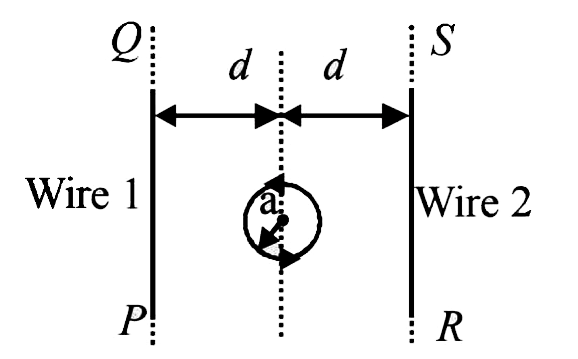Complete Solutions to Archives (linked Comprehension) of chapter SOURCES OF MAGNETIC FIELD of Class 12 book with complete answers and questions
| Class 12 | PHYSICS |
| Chapter | SOURCES OF MAGNETIC FIELD |
| CENGAGE PHYSICS | Archives (linked Comprehension) |
| Number Of Questions | 4 |
| Academic Year | 2023-24 |
The figure shows a circular loop of radius `a` with two long parallel wires `(numbered 1 and 2)` all in the plane of the paper . The distance of each wire from the centre of the loop is `d`. The loop and the wire are carrying the same current `I`. The current in the loop is in the counterclockwise direction if seen from above.
(q) The magnetic fields(B) at `P` due to the currents in the wires are in opposite directions.
(r) There is no magnetic field at `P`.
(s) The wires repel each other.

(4) When `d~~a` but wires are not touching the loop , it is found that the net magnetic field on the axis of the loop at a height h above the loop is zero. In that case
View SolutionThe figure shows a circular loop of radius `a` with two long parallel wires `(numbered 1 and 2)` all in the plane of the paper . The distance of each wire from the centre of the loop is `d`. The loop and the wire are carrying the same current `I`. The current in the loop is in the counterclockwise direction if seen from above.
.

(5) Consider `dgtgta`, and the loop is rotated about its diameter parallel to the wires by `30^(@)` from the position shown in the figure. If the currents in the wire are in the opposite directions, the torque on the loop at its new position will be ( assume that the net field due to the wires is constant over the loop).
View SolutionIn a thin rectangular metallic strip a constant current `I` flows along the positive `x-direction` , as shown in the figure. The length , width and thickness of the strip are `l, w and d`, respectively.
A uniform magnetic field `vec(B)` is applied on the strip along the positive `y- direction` . Due to this, the charge carriers experience a net deflection along the `z- direction` . This results in accumulation of charge carriers on the surface `PQRS` ansd apperance of equal and opposite charges on the face opposite to `PQRS`. A potential difference along the `z-direction` is thus developed. Charge accumulation contiues untill the magnetic force is balanced by the electric force. The current is assumed to be uniformly distributed on the cross- section of the strip and carried by electrons.
Consider two different metallic strips `(1 and 2)` of the same material . Their lengths are the same,widths are `w_(1) and w_(2)` and thickness are `d_(1) and d_(2)` respectively. Two points `K and M` are symmetrically located on the opposite faces parallel to the ` x-y` plane ( see figure) . `V_(1) and V_(2)` are the potential differences between `K and M` in strips ` 1 and 2`, respectively . Then, for a given current `I` flowing through them in a given magnetic field strength `B`, the correct statement(s) is (are)

View SolutionIn a thin rectangular metallic strip a constant current `I` flows along the positive `x`-direction , as shown in the figure. The length , width and thickness of the strip are `l, w and d`, respectively.
A uniform magnetic field `vec(B)` is applied on the strip along the positive `y- direction` . Due to this, the charge carriers experience a net deflection along the `z- direction` . This results in accumulation of charge carriers on the surface `PQRS` ansd apperance of equal and opposite charges on the face opposite to `PQRS`. A potential difference along the `z-direction` is thus developed. Charge accumulation contiues untill the magnetic force is balanced by the electric force. The current is assumed to be uniformly distributed on the cross- section of the strip and carried by electrons.
Consider two different metallic strips `(1 and 2)` of same dimensions `n_(1) and n_(2)`, repectrively . Strip 1 is placed in magnetic field `B_(1)` and strip 2 is placed in magnetic field `B_(2)` , both along positive ` y- directions`. Then ` V_(1) and V_(2)` are the potential differences developed between `K and M` in strips 1 and 2 , respectively . Assuming that the current `I` is the same for both the strips, the correct option(s) is (are)

View Solution
Archives (linked Comprehension) questions and complete solutions for chapter SOURCES OF MAGNETIC FIELD of CENGAGE PHYSICS (ENGLISH) of Class 12
All Exercises from CENGAGE PHYSICS Class 12 PHYSICS SOURCES OF MAGNETIC FIELD
- Archives (fill In The Blanks)
- Archives (integer)
- Archives (linked Comprehension)
- Archives (multiple Correct )
- Archives (single Correct Anser)
- Concept Exercise 2.1
- Concept Exercise 2.2
- Exercise (assertion-reasioning )
- Exercise (integer)
- Exercise (linked Comprehension)
- Exercise (multiple Currect )
- Exercise (single Correct )
- Exercise (subjective )
- Illustration
- single correct Ansewer type
- single correct Answer Type
- Solved Example
- Subjective type